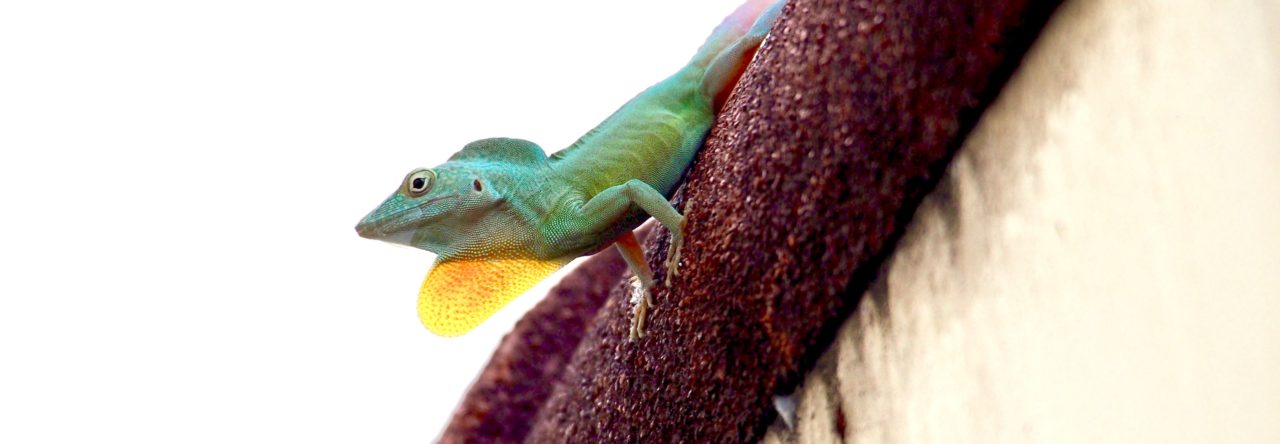
An adult male San Salvador Bark Anole (Anolis distichus ocior) displaying.
Photograph by Guillermo G. Zuniga.
Dayton Antley and colleagues from Avila University, the home of AA stalwart Bob Powell, recently published a detailed study of the ecology of the San Salvador bark anole (Anolis distichus ocior) in IRCF Reptiles & Amphibians (an open-access herpetological journal, with this article available here). Anolis d. ocior is one of 17 recognized subspecies of the diverse distichus group, and is found on only San Salvador and Rum Cay (Henderson and Powell 2009).
Antley et al. assessed microhabitat use, activity patterns, and approach distances of A. d. ocior in an approximately 0.3ha study area on the grounds of the Gerace Research Centre, dominated by Tropical Almonds (Terminalia catappa), Papaya (Carica papaya), and Ficus trees.

A Google Map view of the Gerace Research Centre. The study site
(24°07’05.2″N 74°27’50.9″W) is outlined in white.
In assessing patterns of microhabitat use throughout the day, Antley et al. conducted surveys every two hours for two days from 0700h (about 40 min after sunrise) to 1900h (about 40 min before sunset). Size class, perch height and diameter, body orientation relative to the ground, and thermal microsite (sun/shade/mixed) were recorded for every observed lizard. In the following two days, approach distances were assessed. This was achieved by a surveyor, wearing neutrally-coloured clothing, approaching an undisturbed anole at a steady pace and recording the distance at which the lizard reacted. Over two additional days, 10-minute focal animal observations were conducted of individual adult lizards (including both males and females) at a distance of 5m. The number of movements (changes in location or orientation), head turns, and head bobs were recorded for all lizards, with dewlap displays and pushups being additional recorded for males.
Lizards were active throughout the day, with activity peaking in the early morning and before midday. This was compared to ambient air temperatures recorded 1m from the ground in a shaded and sheltered location. This result surprised the authors, as a second activity peak in late afternoon/early evening was expected, as has observed in other similar studies of bark anoles (e.g. Hillbrand et al. 2011).

Mean number of lizards active (bars) and mean ambient temperatures
(dots) per time period. Temperature data were collected on
two consecutive days.
Adult males experienced highest levels of arboreality during the middle of the day, while subadult males and adult females (grouped together as they can be hard to distinguish from distance) were highly variable (see figure below). Most lizards of all classes were found in the shade, which the authors attributed as evidence for thermal conformity, and facing downward towards the ground, a common trait in many anoles that is most commonly perceived to increase an individual’s ability to monitor potential predators, competitors, or mates. 43% of lizards, however, were observed facing upwards. The author’s note that this behavior is often interpreted as an individual prepared for escape; however as all lizards were observed from distance and undisturbed, they (admirably) explain that this result is difficult to interpret.

A: Mean perch heights (cm) of adult males (L) and subadult males and females (S); B: mean perch heights of adult males at different times of day;
C: mean perch heights of subadult males and females at different times of day.
Adult male lizards were bolder than smaller subadult males and females, and retreated at a much closer distance when approached by a surveyor (0.99m +/- 0.07m vs. 1.54m +/- 0.18m). Focal observations revealed no significant differences between adult males vs. subadult males/females in shared behaviors, although there was a high variation in the amount of displaying behavior between adult males. The average time spent conducting dewlap displays was 3%, although one male was recorded investing 47% of his time in a combination of dewlap extensions and pushup displays.
Using all survey data combined, Antley et al. estimate that A. d. ocior in this study plot had a population density of 593 individuals/ha, with lizards observed on all but four of the smallest trees surveyed. Antley et al. note that their density estimate is extremely conservative, and much lower than previously published estimates (e.g. 1.070-5,460 individuals/ha, Schoener and Schoener 1978). The authors suggest that the small size of the study plot may have contributed to the relatively low density.
In all, this is a charming (although admittedly short) study of the natural history of the San Salvador bark anole (A. d. ocior) – a great example of an undergraduate research project that follows through to publication!
References
– Antley, D.L. et al. 2016. Microhabitat, Activity, and Approach Distances of the San Salvador Bark Anole (Anolis distichus ocior). IRCF Reptiles & Amphibians 23(2): 75-81
– Henderson, R.W. and R. Powell. 2009. Natural History of West Indian Reptiles and Amphibians. University of Florida Press, Gainesville, Florida.
– Hillbrand, P.A., A.T. Sloan, and W.K. Hayes. 2011. The terrestrial reptiles of San Salvador Island, Bahamas. Reptiles & Amphibians 18: 154–166.
– Schoener, T.W. and A. Schoener. 1978. Estimating and interpreting body-size growth in some Anolis lizards. Copeia 1978: 390–405.




























 I just got back from a trip to the Bahamas with Losos lab post-docs
I just got back from a trip to the Bahamas with Losos lab post-docs 

















